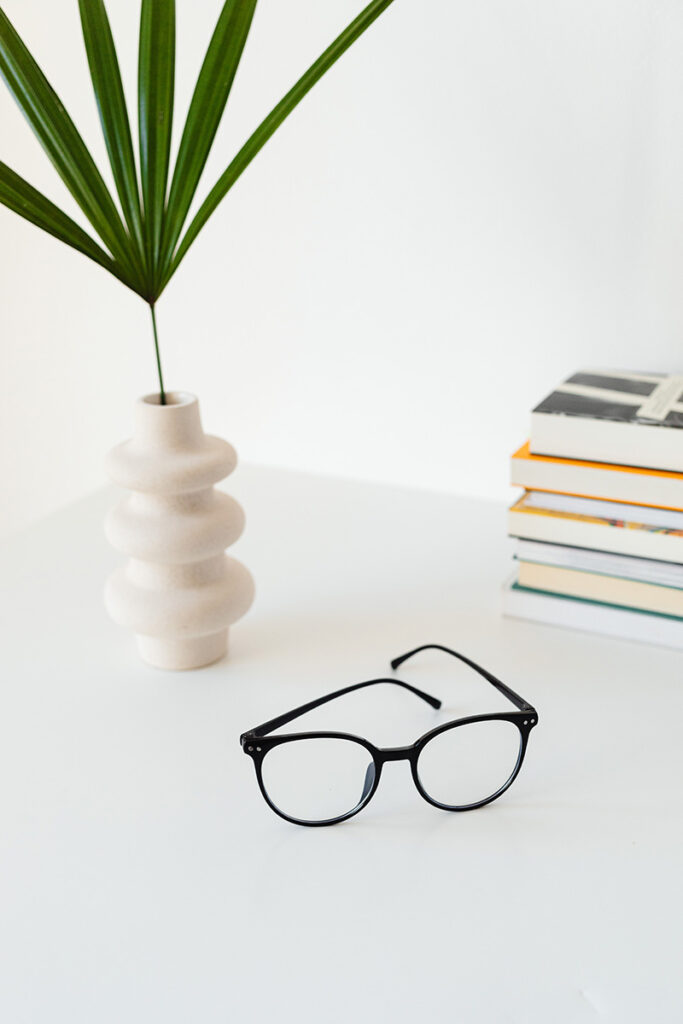How to Improve Nearsightedness Naturally in 7 Ways
As someone who has been living with nearsightedness since the age of eight, I understand the frustration of constantly having to rely on glasses or contact lenses.
While these are useful tools for correcting nearsightedness, they are not a permanent solution and can be inconvenient at times, unless you opt for corrective surgery.
However, a surgery may not be the solution for everyone and can come with its own risks. Plus, it can be expensive as well.
So, yeah, the struggle is real, and you may be wondering if there are any natural ways to improve nearsightedness. Well, the good news is that there are! In fact, here are 7 ways you can try to naturally improve your nearsightedness.

Understanding Nearsightedness
Nearsightedness, or as they call it in the medical world, myopia, is a common vision condition that affects around 30% of the world’s population. It is characterized by being able to see things up close clearly but having difficulty seeing objects far away.
The main cause of nearsightedness is an elongation of the eyeball, which causes light rays to focus in front of the retina instead of directly on it. This can be due to genetic predisposition, excessive screen time, or environmental factors.
In some cases, chronic conditions like diabetes or high blood pressure can also contribute to the development of nearsightedness.
While myopia is not a serious eye condition, it can progress and lead to other vision problems if left untreated. It can also affect the quality of life and limit daily activities, making it important to find ways to improve it.
On the other hand, if you have noticed a sudden or significant decline in your vision, it is important to consult an eye doctor for a proper diagnosis and treatment plan. It can be a sign of an underlying eye condition that requires medical attention.
Nearsightedness Vs. Farsightedness
Before we dive into the natural ways to improve nearsightedness, it is important to understand the difference between nearsightedness and farsightedness.
Farsightedness, also known as hyperopia, is a condition where distant objects appear clear but close-up objects are blurry. This happens when light rays focus behind the retina instead of directly on it, usually due to a shorter eyeball or an irregularly shaped cornea.
While the two conditions may seem similar, they are actually opposites in terms of visual acuity. However, both nearsightedness and farsightedness can be corrected with glasses or contact lenses.

Other Vision Issues
Apart from nearsightedness and farsightedness, there are other eye conditions that can affect your vision. These include astigmatism, presbyopia, and even cataracts.
Astigmatism is a condition where the cornea or lens of the eye has an irregular shape, causing blurred vision at all distances.
Presbyopia, on the other hand, is a natural age-related vision problem where the ability to focus on near objects decreases.
Cataracts are cloudy areas in the lens of the eye that can cause blurred or double vision. While cataracts are more common in older individuals, they can also be caused by trauma or underlying health conditions.
If you have any of these eye conditions, it is important to consult an eye doctor for proper diagnosis and treatment.
How to Improve Nearsightedness Naturally
According to the American Academy of Ophthalmology, there is currently no proven way to prevent nearsightedness.
If wearing glassed or contact lenses or undergoing corrective surgery are not viable options for you, there are natural ways to improve nearsightedness.
These methods may not completely reverse the condition, but they can definitely help in slowing down its progression and improving your overall vision. Plus, they are all healthy lifestyle changes that you can always benefit from.

1. Take Regular Breaks from Screens
In this digital age, it is almost impossible to avoid screens altogether. However, excessive screen time can cause eye fatigue and worsen nearsightedness.
To reduce the impact, you can try the 20-20-20 rule: for every 20 minutes of screen time, take a 20-second break and focus on an object 20 feet away.
Also, before bedtime, try to limit screen time and invest in blue light-blocking glasses if necessary. The blue light from digital devices, like your cell phones, can also disrupt your sleep pattern, which in turn affects the health of your eyes.
Taking regular breaks like this will also help in giving your eyes a rest and reducing fatigue, leading to better eye health. In addition, it can also help you maintain better posture and prevent other health problems associated with excessive screen use.
2. Practice Eye Exercises
Just like any other muscle in our body, our eyes need exercise too. Simple exercises such as focusing on a distant object for 10 seconds, then looking at an object up close for 10 seconds, and repeating the process can help improve your nearsightedness.
Other eye exercises include palming, where you cover your eyes with your palms for a few minutes to give them a break, and blinking regularly to keep your eyes moist and relaxed.
However, it is important to consult an eye doctor before starting any exercise routine to ensure they are safe and suitable for your specific condition.
If you experience any pain or discomfort while performing eye exercises, stop immediately and seek medical advice.

3. Eat a Healthy Diet
A well-balanced diet rich in nutrients is crucial for maintaining overall eye health. This includes foods that are rich in vitamin A, such as carrots, sweet potatoes, and leafy greens.
Beta-carotene, lutein, and zeaxanthin (can be found in eggs) are also important for improving vision and can be found in leafy green vegetables like kale, spinach, and broccoli.
Omega-3 fatty acids found in fish like salmon can also help improve nearsightedness, as well as other eye conditions like dry eyes and macular degeneration – a condition that causes vision loss in older individuals.
Apart from including these foods in your diet, it is also important to limit the consumption of processed and sugary foods, as they can increase inflammation and contribute to eye problems.
4. Get Enough Sunlight
Exposure to natural sunlight can help improve nearsightedness, as it stimulates the release of dopamine in the retina which helps in regulating eye growth.
Spending time outdoors under natural sunlight can help improve your nearsightedness. The sun’s UV rays trigger a chemical process in the retina that promotes the production of dopamine, a neurotransmitter that helps reduce eye elongation.
Make sure to spend some time outdoors every day, even if it’s just for a few minutes. Plus, sunlight also boosts vitamin D production in the body, which is essential for bone and muscle health.
5. Get enough Vitamin D
Studies have shown that individuals with vitamin D deficiency are more likely to develop nearsightedness. That’s because vitamin D plays a crucial role in the development and function of the eyes.
Make sure to get enough vitamin D through sunlight exposure, foods like fish and eggs, or a supplement if needed.
And, if you live in areas with limited sunlight, incorporating vitamin D-rich foods or taking a vitamin D supplement can help improve your nearsightedness. As usual, always consult with a healthcare professional before starting any new supplements.

6. Get Adequate Sleep
Getting enough quality sleep is vital for overall health, including eye health. During sleep, our eyes replenish and repair themselves.
Lack of sleep or poor quality sleep can lead to eye strain and fatigue, which can worsen nearsightedness. Make sure to get at least 7-9 hours of sleep each night to give your eyes the rest they need.
If you wake up having dry eyes or experience blurred vision, it could be a sign that you’re not getting enough quality sleep.
7. Avoid Eye Strain
Finally, it is important to avoid activities that cause eye strain and fatigue. This includes reading or working in low light conditions, squinting too much, or sitting too close to screens.
Try to adjust lighting for comfortable reading and viewing distance, and take breaks when needed. You can also consider using anti-glare screens or glasses to reduce eye strain.
More than just avoiding eye strain, it is important to practice good eye habits in general. This includes keeping your eyes hydrated by drinking enough water and maintaining proper posture while using screens.
Additionally, regular visits to an eye doctor are crucial for monitoring your nearsightedness and ensuring proper treatment if needed.

Other Solutions for Nearsightedness
Aside from lifestyle changes, there are also other methods that can help improve nearsightedness. These include wearing glasses or contacts, undergoing laser surgery, or using orthokeratology – a method where special contact lenses are worn at night to temporarily reshape the cornea and improve vision during the day.
Wearing Glasses or Contacts
Glasses and contact lenses are a common solution for nearsightedness. They work by refracting light onto the retina, allowing distant objects to appear clearer.
Eyeglasses may be more suitable for those with mild to moderate nearsightedness, while contacts can provide better peripheral vision and are more convenient for sports or other physical activities.
Laser Surgery
While it may seem like a quick fix, laser surgery for nearsightedness can have risks and complications. It is important to thoroughly research and consult with an eye doctor before considering this option.
Orthokeratology
Orthokeratology, or ortho-k, involves wearing specially designed contact lenses at night that gently reshape the cornea while you sleep. These lenses are then removed in the morning, leaving you with improved vision during the day.
This method is often recommended for children and teenagers whose eyes are still developing and may help slow down the progression of nearsightedness.
However, like laser surgery, it also carries some risks and should only be done under the supervision of an eye doctor. Regular follow-up appointments are also necessary to monitor progress and make any necessary adjustments.

To Sum Up
While nearsightedness may not be completely reversible, there are natural ways to slow down its progression and improve your vision, though it requires dedication and patience.
Incorporate these tips into your daily routine, and always consult with an eye doctor for personalized advice and treatment options that may be suitable for your specific situation.
If you already have nearsightedness, taking regular eye exams and following these practices can help you maintain proper eye health and prevent further deterioration. Remember, taking care of your eyes now will benefit you in the long run. So, make sure to prioritize them!
Remember, you only have one pair of eyes, so take care of them to maintain good eye health and prevent future problems. Keep in mind that it is never too late to start taking better care of your eyes!





